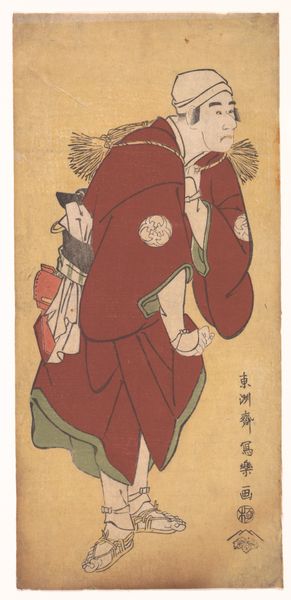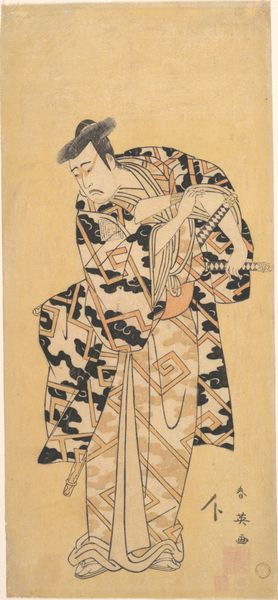
drawing, print, ink, woodblock-print
#
drawing
#
ink drawing
#
narrative-art
#
ink painting
# print
#
asian-art
#
landscape
#
ukiyo-e
#
figuration
#
ink
#
woodblock-print
Dimensions: Image: 26 3/4 x 4 9/16 in. (67.9 x 11.6 cm)
Copyright: Public Domain
Editor: This is "Two Lovers Crossing a River" by Torii Kiyonaga, created sometime between 1767 and 1799. It's an ink and woodblock print. What I immediately notice is the elegant, elongated vertical composition, which emphasizes the height and perhaps the precariousness of their journey. How do you interpret this work from a formalist perspective? Curator: The elegance you observe is a direct result of the interplay between line, form, and space. Note how the flowing lines of the willow branches mirror the ripples in the water and lead the eye down the composition, framing the figures. Consider how the artist uses contrasting blocks of color – the red skirt against the neutral background, the black against the lighter robes – to create visual interest and depth. The print gains its narrative power from the masterful use of these formal elements, wouldn't you agree? Editor: I do agree that the strategic use of line and color heightens the work's emotive quality, but I am not sure about its narrative power? Curator: Notice how the positioning of the figures—close together, almost entwined—creates a sense of intimacy and shared purpose. The very narrow format reinforces the idea of a constrained, shared path. Kiyonaga meticulously constructs not just a visual scene, but an emotionally resonant space through compositional techniques and material qualities alone. What do you make of the use of empty space? Editor: It’s true that the blank space creates a quiet, reflective atmosphere, and the restricted palette certainly adds to it. Considering your viewpoint, I can definitely observe that through this arrangement, the artist guides the viewer's emotional journey with these subjects. Curator: Precisely. The absence is as important as the presence. It’s through analyzing these formal relationships that we can truly grasp the artistic statement. Editor: This has helped me better understand the importance of visual analysis, appreciating how the artist used line, color, and space to evoke a feeling and draw the viewer in. Curator: And hopefully appreciate the reduction of art to its elemental parts that creates aesthetic appeal.
Comments
No comments
Be the first to comment and join the conversation on the ultimate creative platform.













